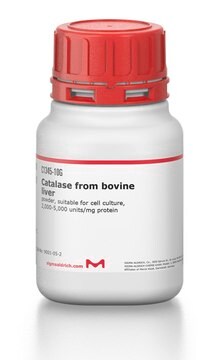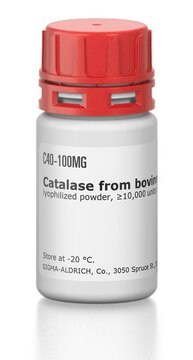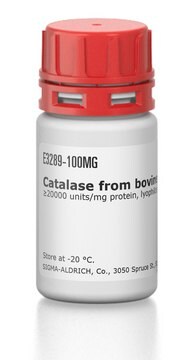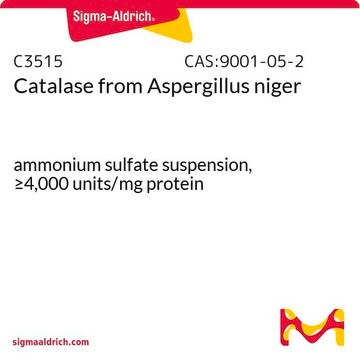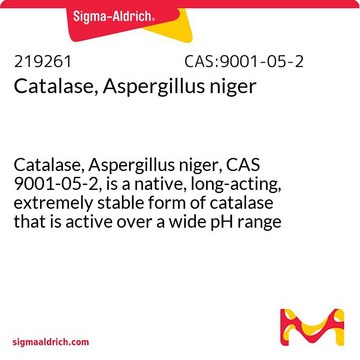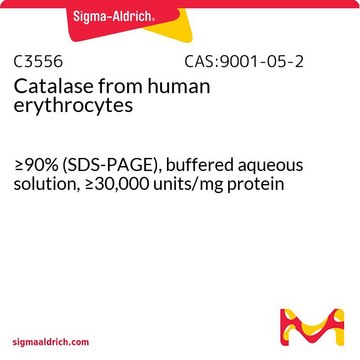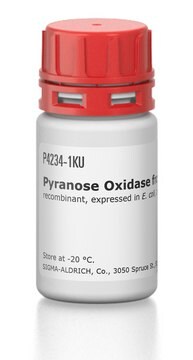C30
Catalase from bovine liver
aqueous suspension, 10,000-40,000 units/mg protein
Synonym(s):
Bovine hepatocatalase, H2O2:H2O2 oxidoreductase
Sign Into View Organizational & Contract Pricing
All Photos(1)
About This Item
CAS Number:
MDL number:
UNSPSC Code:
12352204
eCl@ss:
32160410
NACRES:
NA.54
Recommended Products
biological source
bovine liver
Quality Level
form
aqueous suspension
specific activity
10,000-40,000 units/mg protein
mol wt
tetramer ~250 kDa
concentration
20-50 mg/mL
technique(s)
GC/MS: suitable
isoelectric point
5.4
UniProt accession no.
shipped in
wet ice
storage temp.
2-8°C
InChI
1S/C9H10O3/c1-2-12-9(11)7-3-5-8(10)6-4-7/h3-6,10H,2H2,1H3
InChI key
NUVBSKCKDOMJSU-UHFFFAOYSA-N
Gene Information
cow ... CAT(280743)
Looking for similar products? Visit Product Comparison Guide
General description
Catalase from bovine liver contains 506 residues. It is a tetramer and each monomer corresponds to a molecular weight of 61 kDa. The active site in each momomer comprises nicotinamide adenine dinucleotide phosphate (NADPH) and iron binding region.
Research area: Cell Signaling
Research area: Cell Signaling
Research Area: Cell Signaling
Catalase from bovine liver is a tetramer consisting of 4 equal subunits each with a 60 kDa molecular weight. Each of these subunits contains iron bound to a protoheme IX group. The enzyme will also strongly bind to NADP, where NADP and the heme group are within 13.7 angstroms.
Catalase from bovine liver is a tetramer consisting of 4 equal subunits each with a 60 kDa molecular weight. Each of these subunits contains iron bound to a protoheme IX group. The enzyme will also strongly bind to NADP, where NADP and the heme group are within 13.7 angstroms.
Application
Catalase from bovine liver has been used for measuring the hydrogen peroxide content in cancer tissue homogenates. It has also been used to test the effect of organophosphate insecticide chlorpyrifos-ethyl (CE) [0,0-diethyl 0 (3,5,6-trichloro-2-pyridyl) phosphorothioate] on its enzyme activity.
Catalase from bovine liver is used for the following applications:
- Dielectrophoretic field-flow fractionation (DEP-FFF): It is a chromatographic method in which cell elution times reflect the positions of cells in a hydrodynamic flow profile under the control of sedimentation, DEP and hydrodynamic lift forces, FSED, FDEP and FHDL, respectively. The DEP-FFF buffer consists of catalase along with other ingrediants.
- GC-MS analyses.
- Deionization.
- GC-FID analysis.5
- Functional analysis of blood vessel.
Catalase acts as a natural antioxidant to study the roles of reactive oxygen species in gene expression and apoptosis. It has also been used to protect against oxidative damage to proteins, lipids, and nucleic acids. Industrially, catalzes have been used to remove hydrogen peroxide added to milk and cheese, in textile bleaching, and to examine its positive effects on the viability of DNA-repair mutants of E. coli.
Catalase from bovine liver may be used:
Catalase from bovine liver may be used:
- to prepare H2O2-O2 based biocathode for applications in glucose biofuel cells
- to study the kinetic properties and storage stability of catalase immobilized on to florisil
- in glutathione-mediated superoxide generation in an aqueous solution
Biochem/physiol Actions
Catalase, an antioxidant enzyme found in all aerobic organisms, catalyzes the degradation of hydrogen peroxide, a byproduct of metabolic processes, into less harmful water and oxygen. It can also react with alkylhydrogen peroxides, such as methylperoxide and ethylperoxide and the second H2O2 molecule can be replaced by methanol, ethanol, propanol, formate and nitrate as a hydrogen donor. Catalase enzyme uses either iron (Fe) or manganese (Mn) as cofactor, and are classified as Fe-CAT or Mn-CAT.
This product doesn′t need any activators, but it is inhibited by 3-amino-1-H-1,2,4 triazole, cyanide, azide, hydroxylamine, cyanogens bromide, 2-mercaptoethanol, dithiothreitol, dianisidnie and nitrate.
Caution
Solutions of catalse should not be frozen. Frozen solution will result in a 50-70% loss of activity.
Unit Definition
One unit will decompose 1.0 μmole of H2O2 per min at pH 7.0 at 25 °C, while the H2O2 concentration falls from 10.3 to 9.2 mM, measured by the rate of decrease of A240.
Preparation Note
This product is a crystalline suspension in water containing 0.1% thymol with activity of 10,000-40,000 units/mg.
Storage and Stability
Tightly closed. Dry. Keep locked up or in an area accessible only to qualified or authorized
persons
persons
antibody
Product No.
Description
Pricing
inhibitor
Product No.
Description
Pricing
related product
Product No.
Description
Pricing
Signal Word
Danger
Hazard Statements
Precautionary Statements
Hazard Classifications
Resp. Sens. 1
Storage Class Code
13 - Non Combustible Solids
WGK
WGK 1
Flash Point(F)
Not applicable
Flash Point(C)
Not applicable
Personal Protective Equipment
dust mask type N95 (US), Eyeshields, Gloves
Choose from one of the most recent versions:
Already Own This Product?
Find documentation for the products that you have recently purchased in the Document Library.
Customers Also Viewed
Yusuke Hirose et al.
Viruses, 11(4) (2019-04-19)
Recent large-scale genomics studies of human papillomaviruses (HPVs) have shown a high level of genomic variability of HPV16, the most prevalent genotype in HPV-associated malignancies, and provided new insights into the biological and clinical relevance of its genetic variations in
The complete amino acid sequence of bovine liver catalase and the partial sequence of bovine erythrocyte catalase
Schroeder WA, et al.
Archives of Biochemistry and Biophysics, 214(1), 397-421 (1982)
The effect of organophosphate insecticide chlorpyrifos-ethyl on lipid peroxidation and antioxidant enzymes (in vitro)
Gultekin F, et al.
Archives of Toxicology, 74(9), 533-538 (2000)
Haïfa Debbabi et al.
Molecules (Basel, Switzerland), 25(9) (2020-05-07)
The present investigation was focused on the study of the chemical composition variability and biological activities of the essential oils from Clinopodium nepeta subsp. nepeta and subsp. glandulosum. Essential oils extraction was performed using hydrodistillation and the separation of the
Manganese superoxide dismutase (SOD2/MnSOD)/catalase and SOD2/GPx1 ratios as biomarkers for tumor progression and metastasis in prostate, colon, and lung cancer
Miar A, et al.
Free Radical Biology & Medicine, 85, 45-55 (2015)
Our team of scientists has experience in all areas of research including Life Science, Material Science, Chemical Synthesis, Chromatography, Analytical and many others.
Contact Technical Service
